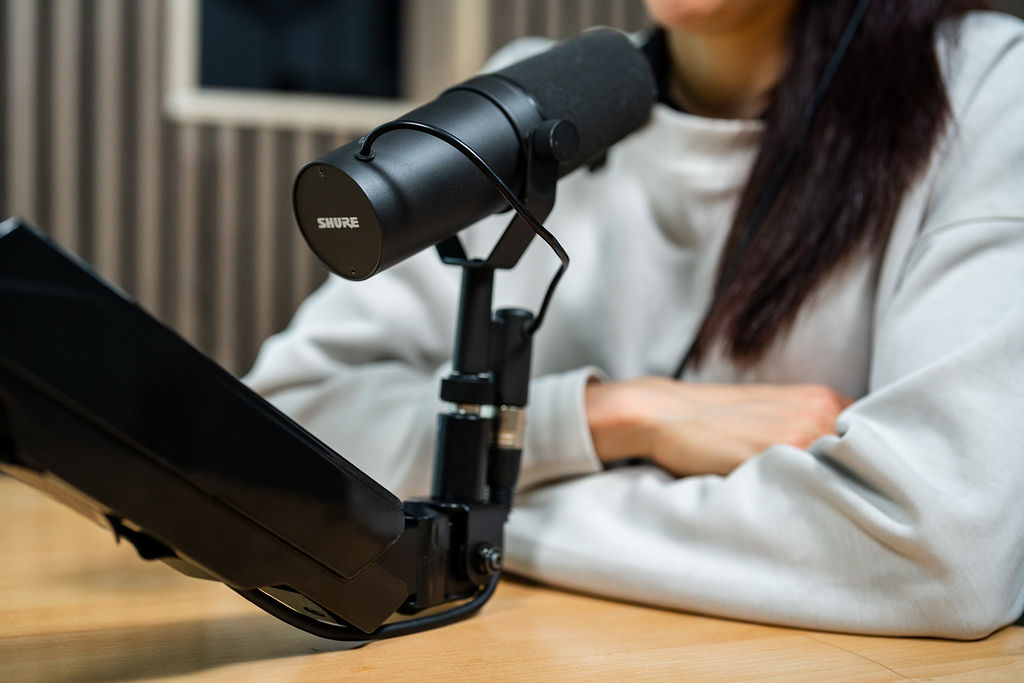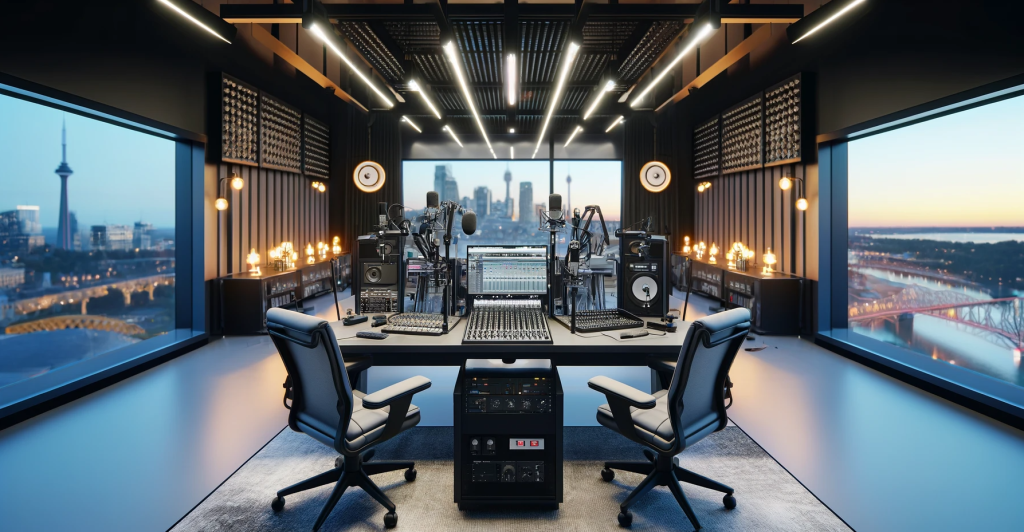Choosing your microphone is one of the most important decisions for your studio. Is your podcast fully soundproof? How much noise can you tolerate? Do you need a dynamic mic that is less sensitive to background noise or a condenser mic with higher sensitivity to capture minute nuances?
For home studios with some background noise, a cardioid dynamic microphone is probably a much better idea. In contrast, if you record in a professionally treated space, a condenser microphone such as the Rode NT-USB or Blue Yeti is probably going to be a better fit. In the article below, we will explore everything you need to consider, along with some of the best choices in Canada in the field, from a budget-friendly range to the premium quality tier.
We have prepared the complete guide for buying your podcast mics in Canada. Below are some of the best options for your brand-new professional podcast studio. However, we have also prepared some answers to commonly asked questions below. Before investing in a mic, make sure to have an answer to these key questions:
- How do you choose the right podcast mic for your studio?
- What is the Difference Between a USB Podcast Microphone and an XLR Microphone?
- What are the Best Low Profile Podcast Arms?
Top 5 microphone recommendations for Podcasting in Canada in 2025
Podcasting is expected to triple by 2030. With everyone trying to be the new Joe Rogan in the maple leaf country, the soundscape has also become incredibly saturated. Making sure you have the right mic for your voice will make a major difference. Based on our conversations with industry partners, the Ottawa podcast community, and top resellers, here are the top podcast microphones you can get in Canada for your new studio.
Without further ado, let’s dive right into it.
1. Shure MV7X
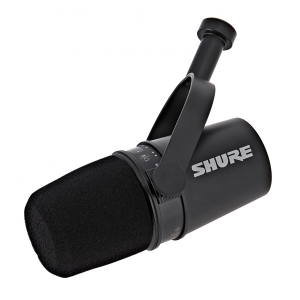
Price Range: $249-279 CAD
The Shure MV7X is a modern evolution inspired by Shure’s iconic SM7B, optimized for the modern podcaster. This 2025 update maintains its predecessor’s exceptional vocal reproduction while adding features specifically requested by the Canadian podcasting community.
What Podcasters Like
The MV7X excels in less-than-ideal recording environments. The MV7X is reliable and adaptable. Before you buy, remember there is two versions of this mic for different needs. The MV7X has an XLR connection (more of this at the bottom of the page), and the MV7+ has both USB-C and XLR. We explain this in a later section, but for now, let’s just say that for beginners, the USB-C connection offers plug-and-play simplicity with surprisingly good preamps, while the XLR option provides a professional upgrade path when you’re ready to invest in a mixing board or audio interface.
On top of that, Shure is also much more present in the Canadian market for customer service.
What reviewers also say :
- MusicTech
“We love the sound of the MV7, and Shure’s revoicing of the MV7+ makes us smile even more. It’s not quite an SM7B, but it’s the closest you can get with the convenience of USB connectivity.” - AVNetwork
“Whether you’re a podcaster or hosting town hall meetings for your company and clients, the professional feel paired with ease of use that the Shure MV7+ provides is worth the investment.” - SoundGuys
“With its updated USB-C connection and extended windscreen, the Shure MV7+ provides some welcome upgrades over the original and remains an excellent option for podcasters and content creators alike.”
2. Audio-Technica BP40 Large-Diaphragm Dynamic Broadcast Microphone
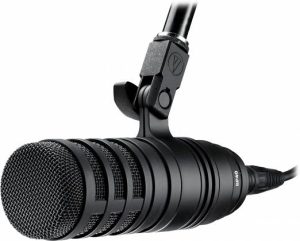
Price Range: $399–449 CAD
The Audio-Technica BP40 is a top-tier dynamic broadcast microphone designed for professional podcast studios. With its large diaphragm and rich low-end response, the BP40 offers a warm, broadcast-quality audio much like your typical radio experience. For superior quality conversations that feel intimate and insightful, this is the mic for the job.
What Podcasters Like
What makes the BP40 stand out is its ability to deliver the clarity of a condenser with the reliability of a dynamic mic. The result, an immediate confidence boost from hearing yourself sound like a professional radio host. It’s no wonder several podcasts have made the switch.
The BP40 excels in untreated environments like basement studios or spare bedrooms, where it naturally rejects ambient noise such as furnace hums or nearby traffic. Its hypercardioid polar pattern provides excellent off-axis noise rejection, essential for creators working in shared or less-than-ideal spaces.
The BP40 comes with a custom shock mount (AT8484), an accessory many other brands sell separately.
What reviewers say:
- Radio World
“It’s the multistage windscreen and the deep capsule placement that sets the BP40 apart, way apart, at the head of the pack, in my ears. [It has a] natural depth, rich and rounded, in the 300 Hz to 3 kHz range that the human brain finds so attractive. It’s where the crooners pitch their love songs.” - AudioTechnology
“Audio-Technica’s BP40 large diaphragm dynamic microphone comes pre-tuned for speech. Its hypercardioid pattern and scooped response give you plenty of definition whether you’re up on the mic or backed off.” - zZounds User Review
“The hypercardioid pattern on a large-diaphragm dynamic platform is a brilliant design. It’s got a sparkling top end, a bit of a scooped midrange, and a smooth bottom end. Very little proximity effect… Excellent sibilance and plosion rejection.”
3. Rode PodMic
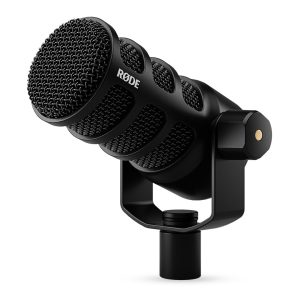
Price Range: $159-179 CAD
The RØDE PodMic is a dynamic microphone designed specifically for podcasting, offering excellent sound quality at an accessible price point. Again, this is an industry-stable trusted by thousands of podcasters. This is your low-medium tier, plug-and-play microphone with a track record of sound accuracy on a budget. The sound quality easily compares with the classic Shure SM58, except with less noise handling. While not perfect, the Rode PodMic offers a great solution for beginners and pros alike.
What Podcasters Like
Compared to classics like the Shure SM58, the PodMic holds its own with better plosive control and lower handling noise. For beginner and intermediate podcasters, it delivers impressive value and a polished, professional sound right out of the box.
While not as versatile as some studio microphones, it is still pretty good at capturing voice with warmth and clarity. Just be careful to speak real close, and by that we mean less than 10 cm away.
The PodMic 2 features a refined internal shock mounting system that effectively reduces handling noise and vibration transfer from desks and stands. Its cardioid pickup pattern does a solid job of rejecting ambient noise, which is useful in shared or untreated spaces. Very handy when you are in a hurry.
What reviewers say:
- GameRevolution
“Great sound that responds well to post processing. Timeless look. Fantastic build quality. Internal pop filter. Lackluster unboxing experience. Integrated shock mount isn’t very effective.” - MusicTech
“Tonally, the PodMic has a decent amount of low-end, with a hump at around 150Hz. The mids are articulate with small peaks at about 900Hz, 4kHz, and 5.5kHz, notably dipping in the sibilant 7kHz region. Finally, there’s a small boost around 9 kHz for a little sheen, rolling off from about 11 to 15 kHz. The result is a mic that sounds polished without much processing.” - Podcast.co
“The Rode PodMic has DEFINITELY been designed with Podcasters in mind. Its small and lightweight nature, meaning it’s perfect for carting around to on-location recordings, and in a little studio, it won’t take up much space. Paired with the Rodecaster Pro, it makes for the perfect portable podcasting studio… The only downside we can see is that it is quite treble-heavy with not a lot of bass in there.”
4. Shure SM7B & SM7dB (2025)
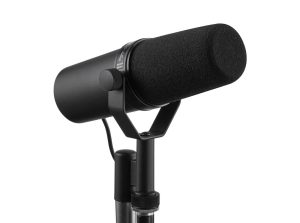
Price Range: $529–639 CAD
Shure’s legendary SM7B remains one of the most trusted microphones in professional podcasting, and the newer SM7dB brings a built-in preamp to the mix, solving one of the most common challenges podcasters have faced for years. This one is close to home, as this is the one mic we have chosen for most of our studios in Canada.
What Podcasters Like
The Shure SM7B has long been known for its smooth, broadcast-quality sound, its rugged build, and its ability to reject unwanted background noise. It thrives in less-than-perfect acoustic environments.
The newer SM7dB, launched with podcasters in mind, builds on the SM7B’s legacy by integrating a clean, switchable preamp that eliminates the need for an expensive Cloudlifter or high-gain interface. This makes it far more accessible for independent creators, especially those building a studio on a tighter budget.
The SM7 dB’s integrated preamp is a game-changer for professionals and prosumers alike. The built-in gain boost delivers the same clean amplification as a dedicated Cloudlifter, but without the additional cost, desk space, or cable complexity. This means you can achieve that coveted broadcast-quality sound straight from the microphone, whether you’re using a basic audio interface or connecting directly to a portable recorder
What Reviewers Say
- GamesRadar+
“The Shure SM7dB is the first major update to the world’s most immediately recognizable content creation mic. The SM7 dB takes the incredible quality of the SM7 B and adds an internal pre-amp that will boost … .” - SoundGuys
“Thanks to its wide frequency response, getting a clear and full-sounding vocal performance out of this microphone is incredibly easy.” - MusicRadar
“For anyone upgrading an existing mic, there are few models on the market today we’d recommend more highly than the SM7dB. We’d even recommend it for existing SM7B users, who will benefit greatly from the added flexibility that comes with the active preamp.”
5. Electro-Voice RE320-C
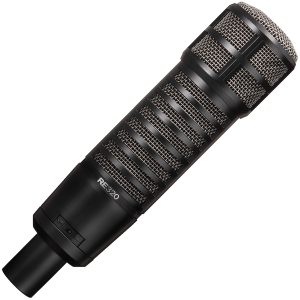
Price Range: $379-429 CAD
The Electro-Voice RE320-C is a solid, durable professional broadcast-quality dynamic microphone that delivers a clean and smooth sound. This has a hotter output than the Shure SM7 B. This highly sensitive microphone needs a thoroughly soundproof studio but packs in a high-caliber radio-quality sound without needing additional equalization (EQ) adjustments. The RE320 needs a bit of space, so be sure to speak close but not too close.
Podcasters like
The RE320-C delivers broadcast-quality sound with a Variable-D pattern that minimizes proximity effect—the bass boost that occurs when speaking close to the microphone. That means an even crisp sound across the board: no need to worry about those popping “P”. The microphone’s internal pop filter and shock mount reduce the need for additional accessories, streamlining portable recording setups.
The package includes a premium XLR cable, additional foam windscreen, and extended warranty service through Canadian authorized dealers. Electro-Voice has also established relationships with several Canadian audio equipment rental companies, allowing podcasters to try before they buy.
- Podcastage
“This is a Broadcast Dynamic Mic that is a great option if the RE20 or SM7 B are out of your budget. It has a great tone for spoken word, does great at off-axis & rear rejection, and doesn’t suffer from a boomy proximity effect.” - Microphone Geeks
“It is great for spoken word and singing when you want to capture all the detail and nuances while giving it a touch of silkiness and smoothness of a dynamic.” - Podcast.co
“Audio is clear, punchy, and offers brilliant low-end bass you often hear in traditional radio station condenser microphones, all without sounding muddy.”
Honorable Mentions
While not making our top five, these microphones deserve consideration for specific use cases:
- Samson Q2U Pro (2025) – $99-119 CAD: Excellent starter microphone with dual USB/XLR connectivity
- HyperX QuadCast S2 – $189-209 CAD: Great for gaming podcasters with RGB lighting and integrated shock mount
- Earthworks Audio ETHOS-C – $449-499 CAD: Premium condenser microphone with exceptional clarity for treated spaces
- DJI Mic 2 Pro – $299-329 CAD: Wireless solution for on-the-go podcasters recording in multiple locations
Where to Buy in Canada
Canadian podcasters have several reliable options for purchasing equipment:
- B&H Canada: A highly responsive U.S. retailer with international shipping, excellent customer service, and the option to prepay duties and taxes—ideal for high-end gear seekers.
- Long & McQuade: Canada’s most established music retailer, with locations across the country and knowledgeable in-store staff.
- Steve Music: A trusted Canadian retailer with physical stores in major cities, offering a curated selection of pro audio gear and personalized service from staff who understand the needs of musicians and podcasters alike.
- Amazon.ca: Extremely convenient with a vast selection and competitive pricing. Just be sure to verify seller credibility and warranty coverage, especially when buying from third-party vendors. Beware: there might be a duty tax depending on the seller’s country.
How to Choose a Microphone That is Right for Your Podcast
Before you dive in, be honest about your tech comfort level. Are you the type who enjoys figuring out new equipment, or do you prefer keeping things simple? There’s no wrong answer – just know what you’re getting into.
Your podcast format matters, too. Flying solo or doing remote interviews? One solid microphone with good background noise rejection will do the trick. But if you’re planning to have friends or co-hosts sitting around the same table, you’ll want to think about individual mics for everyone. Sure, you could try one omnidirectional mic in the center, but you might end up with audio that sounds a bit muddy.
Our best advice: test before you commit. It’s worth visiting a few professional studios and asking around for tips. Your voice, your recording space, even your desk setup – they all affect how a microphone performs. Most stores have pretty forgiving return policies these days, so take advantage of that. Record a few test episodes and listen to how you sound. After all, you’ll be hearing your voice a lot more than you might expect!
What is the Difference Between a USB Podcast Microphone and an XLR Microphone?
Connection type is a key decision for your studio. USB microphones offer a plug-and-play solution ideal for beginners on a budget, and XLR microphones give you the high-end golden voice but require a more complicated setup.
USB microphones are ideal for simplicity. They plug directly into your computer and contain both a microphone and an audio interface in one unit. This makes them great for beginners, solo podcasters, or creators on the go. According to Buzzsprout, USB mics like the Blue Yeti or RØDE NT-USB offer solid sound quality and are extremely easy to use — just plug and record.
That said, if you want to step up, then XLR microphones are the industry standard for professional podcast studios. As RØDE explains, XLR mics provide greater flexibility, expandability, and superior audio quality.
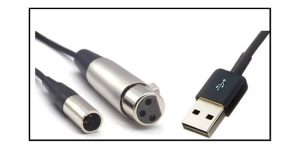
They require an external audio interface or mixer (like the RØDECaster Pro or Focusrite Scarlett), which gives you more control over gain, EQ, effects, and multi-mic setups. This is crucial if you’re recording more than one person or want to upgrade your audio chain over time.
USB mics are great for hobbyists or mobile setups, but the moment you’re handling multiple guests, remote interviews, or longform production, XLR becomes indispensable. You can make a USB mic sound good, but you can’t scale it. Another issue with USB setups is that they can introduce latency or be more prone to ground loop noise, especially when paired with consumer-level gear or cheaper laptops.
Two other factors to consider: redundancy and repairability. With XLR, if your interface breaks, you can swap it. With USB, the mic is often a single point of failure. That modularity is critical in professional environments.
When Should I Buy a Mic Kit?
A mic kit is a matched pair or bundle of microphones and accessories designed for stereo recording or complete setup convenience.
Buy a Mic Kit If You’re ready to record in stereo (X/Y, ORTF, Blumlein, or spaced pair techniques). This is especially useful for:
- Overhead drum miking
- Acoustic instruments (guitar, piano, string quartets)
- Ambience or room miking
- Field recordings or orchestras
Unless you’re doing precision stereo recordings where sonic balance between mics is vital, it’s perfectly fine to buy one great mic and get a second later. Focus on performance and build quality over labels.
Let your needs, not hype, guide your gear choices.
What are the Best Profile Podcast Arms?
Low-profile podcast arms keep your microphone secure and adjustable while staying out of your camera shot. They’re perfect for video podcasters and streamers who want a clean, professional desk setup without the bulk of traditional scissor arms.
We’ve selected two excellent options for Canadian creators: one that offers the best overall value, and a strong budget alternative when available. Both deliver the sleek cable management and streamlined design that modern content creators need to maintain a polished on-screen appearance.
Best Value / Best All-Rounder for Creators:
Elgato Wave Mic Arm LP
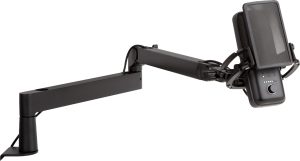
Pros:
- Sleek design, magnetic cable management.
- Smooth operation.
- Inexpensive for the quality (≈ $100–$120).
- V2 improved on an earlier version.
Cons
- Limited reach for larger desks like your upcoming 84″x36″.
Use case: Ideal for streamers, podcasters, and small studios wanting a clean look and reliability without overspending.
Highly praised on Reddit. Durable, affordable, and refined.
Best Budget Option with Features:
Neewer Low Profile Pneumatic Arm
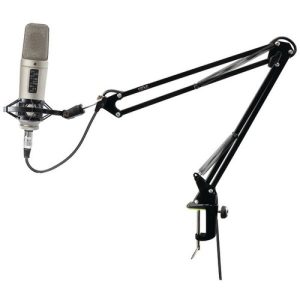
Pros:
- Pneumatic movement for smooth adjustment.
- Extra articulation point (more flexible than Elgato and OC White).
- Affordable (≈ $80) — great value.
- Can support heavy mics like the Rode Procaster.
Cons:
- Hard to find — often sold out.
- Brand not as trusted long-term as OC White or Elgato.
Use case: If you find one in stock, buy it immediately. Best sub-$100 choice by far.
🚫 Avoid:
- VIVO pneumatic (Stand-MIC01) — Functional, but bulky and unattractive. One Reddit user reverted back to Elgato after using it.
- Ultima Gen2, if you mind plastic at high cost — although it’s still very functional.
Best Resources on Podcast Mics in Canada in 2025
- Canadian Podcast Association. (2025). Annual Survey of Canadian Podcasters: Equipment Preferences 2025. https://www.canadianpodcasts.org/research/equipment-survey-2025
- Broadcast Canada. (2025). Audio Equipment Performance in Varying Canadian Climates. https://www.broadcastcanada.ca/research/audio-climate-testing
- Rodriguez, J. (2025). The 2025 Podcast Microphone Guide. Sound on Sound Magazine. https://www.soundonsound.com/podcast-microphone-guide-2025
- Podcasting.ca. (2025). Canadian Podcaster Equipment Market Report. https://www.podcasting.ca/market-report-2025
- Acoustic Sciences Corporation. (2025). North American Home Acoustics Study. https://www.acousticsciences.com/research/north-american-home-study
- Audio Engineering Society – Canadian Section. (2025). Technical Standards for Podcast Production in Canada. https://www.aes.org/canada/podcast-standards-2025

